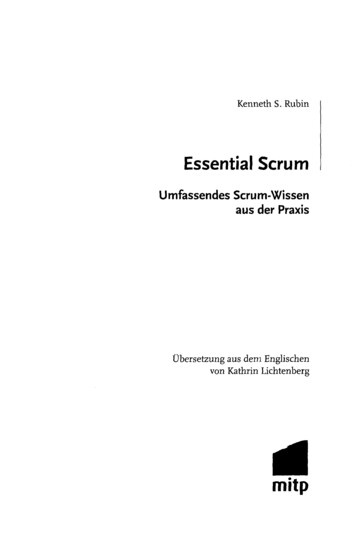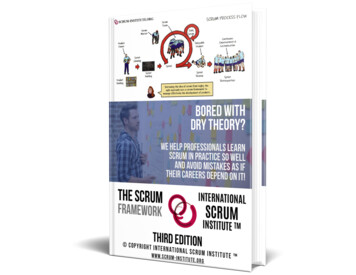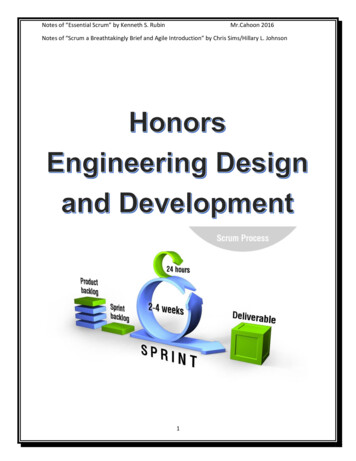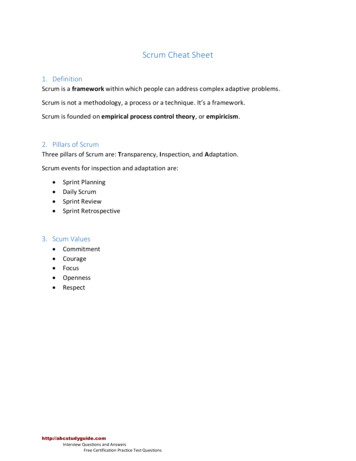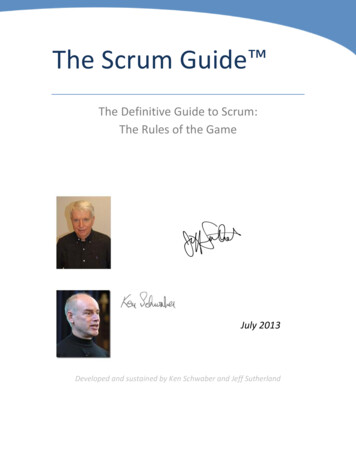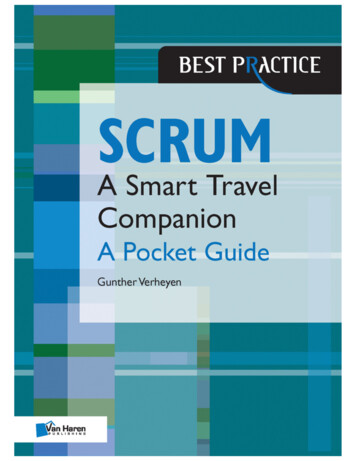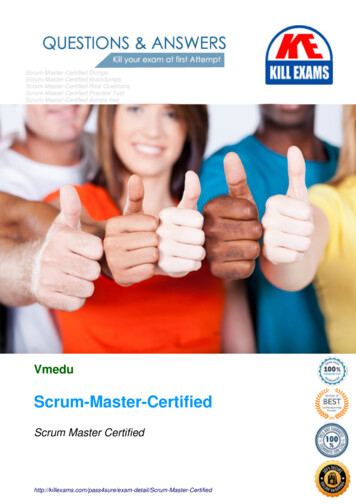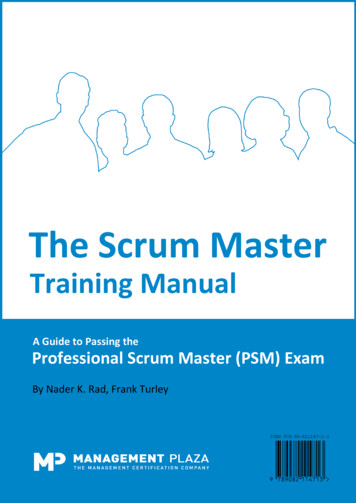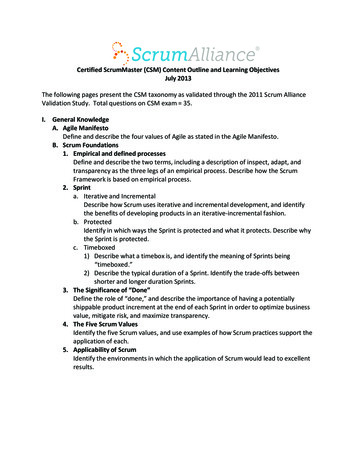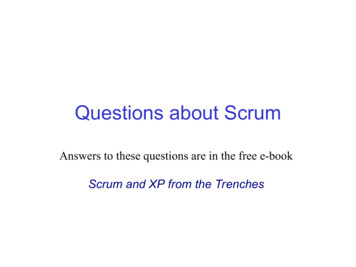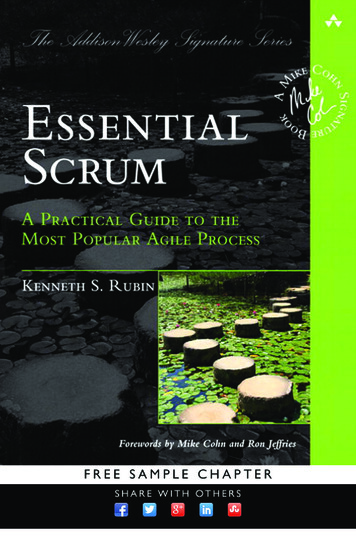
Transcription
Chapter 2SCRUM FRAMEWORKThis chapter provides an overview of the Scrum framework with a primary focus onits practices, including roles, activities, and artifacts. Subsequent chapters will provide a deeper treatment of each of these practices, including an in-depth look at theprinciples that underlie the practices.OverviewScrum is not a standardized process where you methodically follow a series of sequential steps that are guaranteed to produce, on time and on budget, a high-qualityproduct that delights customers. Instead, Scrum is a framework for organizing andmanaging work. The Scrum framework is based on a set of values, principles, andpractices that provide the foundation to which your organization will add its uniqueimplementation of relevant engineering practices and your specific approaches forrealizing the Scrum practices. The result will be a version of Scrum that is uniquelyyours.To better grasp the framework concept, imagine that the Scrum framework is likethe foundation and walls of a building. The Scrum values, principles, and practiceswould be the key structural components. You can’t ignore or fundamentally changea value, principle, or practice without risking collapse. What you can do, however, iscustomize inside the structure of Scrum, adding fixtures and features until you havea process that works for you.Scrum is a refreshingly simple, people-centric framework based on the values ofhonesty, openness, courage, respect, focus, trust, empowerment, and collaboration.Chapter 3 will describe the Scrum principles in depth; subsequent chapters will highlight how specific practices and approaches are rooted in these principles and values.The Scrum practices themselves are embodied in specific roles, activities, artifacts, and their associated rules (see Figure 2.1).The remainder of this chapter will focus on Scrum practices.13
14Chapter 2 Scrum FrameworkProduct ownerRolesScrumMasterDevelopment teamSprintSprint planningDaily scrumActivitiesScrum practicesSprint executionSprint reviewSprint retrospectiveProduct backlog groomingProduct backlogArtifactsSprint backlogPotentially shippable product incrementRulesDescribed throughout the bookFIGURE 2.1 Scrum practicesScrum RolesScrum development efforts consist of one or more Scrum teams, each made up ofthree Scrum roles: product owner, ScrumMaster, and the development team (seeFigure 2.2). There can be other roles when using Scrum, but the Scrum frameworkrequires only the three listed here.
Scrum Roles15Scrum teamScrumMasterProduct ownerDevelopment teamFIGURE 2.2 Scrum rolesThe product owner is responsible for what will be developed and in what order.The ScrumMaster is responsible for guiding the team in creating and followingits own process based on the broader Scrum framework. The development team isresponsible for determining how to deliver what the product owner has asked for.If you are a manager, don’t be concerned that “manager” doesn’t appear as a rolein Figure 2.2; managers still have an important role in organizations that use Scrum(see Chapter 13). The Scrum framework defines just the roles that are specific toScrum, not all of the roles that can and should exist within an organization that usesScrum.Product OwnerThe product owner is the empowered central point of product leadership. He1 is thesingle authority responsible for deciding which features and functionality to buildand the order in which to build them. The product owner maintains and communicates to all other participants a clear vision of what the Scrum team is trying toachieve. As such, the product owner is responsible for the overall success of the solution being developed or maintained.It doesn’t matter if the focus is on an external product or an internal application; the product owner still has the obligation to make sure that the most valuablework possible, which can include technically focused work, is always performed. To1. In this book the product owner will always be referred to as “he” or “him” and the ScrumMasteras “she” or “her.” This is consistent with the visual representation of each role within the figures.
16Chapter 2 Scrum Frameworkensure that the team rapidly builds what the product owner wants, the product owneractively collaborates with the ScrumMaster and development team and must beavailable to answer questions soon after they are posed. See Chapter 9 for a detaileddescription of the product owner role.ScrumMasterThe ScrumMaster helps everyone involved understand and embrace the Scrum values, principles, and practices. She acts as a coach, providing process leadership andhelping the Scrum team and the rest of the organization develop their own highperformance, organization-specific Scrum approach. At the same time, the ScrumMaster helps the organization through the challenging change management processthat can occur during a Scrum adoption.As a facilitator, the ScrumMaster helps the team resolve issues and make improvements to its use of Scrum. She is also responsible for protecting the team from outsideinterference and takes a leadership role in removing impediments that inhibit teamproductivity (when the individuals themselves cannot reasonably resolve them). TheScrumMaster has no authority to exert control over the team, so this role is not thesame as the traditional role of project manager or development manager. The ScrumMaster functions as a leader, not a manager. I will discuss the roles of functionalmanager and project manager in Chapter 13. See Chapter 10 for more details on theScrumMaster role.Development TeamTraditional software development approaches discuss various job types, such asarchitect, programmer, tester, database administrator, UI designer, and so on. Scrumdefines the role of a development team, which is simply a diverse, cross-functionalcollection of these types of people who are responsible for designing, building, andtesting the desired product.The development team self-organizes to determine the best way to accomplish thegoal set out by the product owner. The development team is typically five to nine people in size; its members must collectively have all of the skills needed to produce goodquality, working software. Of course, Scrum can be used on development efforts thatrequire much larger teams. However, rather than having one Scrum team with, say, 35people, there would more likely be four or more Scrum teams, each with a development team of nine or fewer people. See Chapter 11 for more details on the development team role and Chapter 12 for more details on coordinating multiple teams.Scrum Activities and ArtifactsFigure 2.3 illustrates most of the Scrum activities and artifacts and how they fittogether.
Scrum Activities and Artifacts17Daily scrumSprint planningSprint backlogProduct backlogSprint executionGroomingPotentiallyshippable productincrementSprint retrospectiveSprint reviewFIGURE 2.3 Scrum frameworkLet’s summarize the diagram, starting on the left side of the figure and workingclockwise around the main looping arrow (the sprint).The product owner has a vision of what he wants to create (the big cube). Becausethe cube can be large, through an activity called grooming it is broken down into aset of features that are collected into a prioritized list called the product backlog.A sprint starts with sprint planning, encompasses the development work duringthe sprint (called sprint execution), and ends with the review and retrospective. Thesprint is represented by the large, looping arrow that dominates the center of the figure. The number of items in the product backlog is likely to be more than a development team can complete in a short-duration sprint. For that reason, at the beginningof each sprint, the development team must determine a subset of the product backlogitems it believes it can complete—an activity called sprint planning, shown just tothe right of the large product backlog cube.As a brief aside, in 2011 a change in “The Scrum Guide” (Schwaber and Sutherland 2011) generated debate about whether the appropriate term for describing theresult of sprint planning is a forecast or a commitment. Advocates of the word forecastlike it because they feel that although the development team is making the best estimate that it can at the time, the estimate might change as more information becomesknown during the course of the sprint. Some also believe that a commitment on thepart of the team will cause the team to sacrifice quality to meet the commitment orwill cause the team to “under-commit” to guarantee that the commitment is met.I agree that all development teams should generate a forecast (estimate) of whatthey can deliver each sprint. However, many development teams would benefit from
18Chapter 2 Scrum Frameworkusing the forecast to derive a commitment. Commitments support mutual trustbetween the product owner and the development team as well as within the development team. Also, commitments support reasonable short-term planning and decisionmaking within an organization. And, when performing multiteam product development, commitments support synchronized planning—one team can make decisionsbased on what another team has committed to do. In this book, I favor the term commitment; however, I occasionally use forecast if it seems correct in context.To acquire confidence that the development team has made a reasonable commitment, the team members create a second backlog during sprint planning, calledthe sprint backlog. The sprint backlog describes, through a set of detailed tasks, howthe team plans to design, build, integrate, and test the selected subset of features fromthe product backlog during that particular sprint.Next is sprint execution, where the development team performs the tasks necessary to realize the selected features. Each day during sprint execution, the teammembers help manage the flow of work by conducting a synchronization, inspection,and adaptive planning activity known as the daily scrum. At the end of sprint execution the team has produced a potentially shippable product increment that representssome, but not all, of the product owner’s vision.The Scrum team completes the sprint by performing two inspect-and-adaptactivities. In the first, called the sprint review, the stakeholders and Scrum teaminspect the product being built. In the second, called the sprint retrospective, theScrum team inspects the Scrum process being used to create the product. The outcome of these activities might be adaptations that will make their way into the product backlog or be included as part of the team’s development process.At this point the Scrum sprint cycle repeats, beginning anew with the development team determining the next most important set of product backlog items it cancomplete. After an appropriate number of sprints have been completed, the productowner’s vision will be realized and the solution can be released.In the remainder of this chapter I will discuss each of these activities and artifacts in greater detail.Product BacklogUsing Scrum, we always do the most valuable work first. The product owner, withinput from the rest of the Scrum team and stakeholders, is ultimately responsiblefor determining and managing the sequence of this work and communicating it inthe form of a prioritized (or ordered) list known as the product backlog (see Figure2.4). On new-product development the product backlog items initially are featuresrequired to meet the product owner’s vision. For ongoing product development, theproduct backlog might also contain new features, changes to existing features, defectsneeding repair, technical improvements, and so on.The product owner collaborates with internal and external stakeholders to gatherand define the product backlog items. He then ensures that product backlog items
Scrum Activities and ArtifactsFeature AFeature BFeature CDefect 2319High-priority itemsRefactor XFeature DFeature EFeature FFIGURE 2.4Low-priority itemsProduct backlogare placed in the correct sequence (using factors such as value, cost, knowledge, andrisk) so that the high-value items appear at the top of the product backlog and thelower-value items appear toward the bottom. The product backlog is a constantlyevolving artifact. Items can be added, deleted, and revised by the product owner asbusiness conditions change, or as the Scrum team’s understanding of the productgrows (through feedback on the software produced during each sprint).Overall the activity of creating and refining product backlog items, estimatingthem, and prioritizing them is known as grooming (see Figure 2.5).Product backlogFeature AFeature BFeature CPrioritizingCreatingand refiningFIGURE 2.5Product backlog groomingEstimating
20Chapter 2 Scrum FrameworkAs a second brief aside, in 2011 there was another debate as to whether theappropriate term for describing the sequence of items in the product backlog shouldbe prioritized (the original term) or ordered, the term used in “The Scrum Guide”(Schwaber and Sutherland 2011). The argument was that prioritizing is simply oneform of ordering (and, according to some, not even the most appropriate form ofordering). The issue of how to best sequence items in the product backlog, however, isinfluenced by many factors, and a single word may never capture the full breadth anddepth of the concept. Although there may be theoretical merit to the ordered-versusprioritized debate, most people (including me) use the terms interchangeably whendiscussing the items in the product backlog.Before we finalize prioritizing, ordering, or otherwise arranging the productbacklog, we need to know the size of each item in the product backlog (see Figure 2.6).Size equates to cost, and product owners need to know an item’s cost to properlydetermine its priority. Scrum does not dictate which, if any, size measure to use withproduct backlog items. In practice, many teams use a relative size measure such asstory points or idea
Scrum team inspects the Scrum process being used to create the product. The out-come of these activities might be adaptations that will make their way into the prod-uct backlog or be included as part of the team’s development process. At this point the Scrum sprint cycle repeats, beginning anew with the develop- ment team determining the next most important set of product backlog items it .
